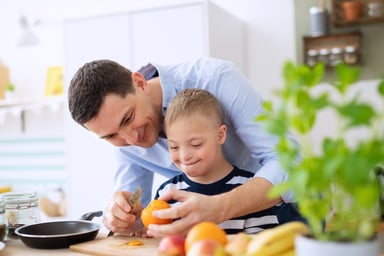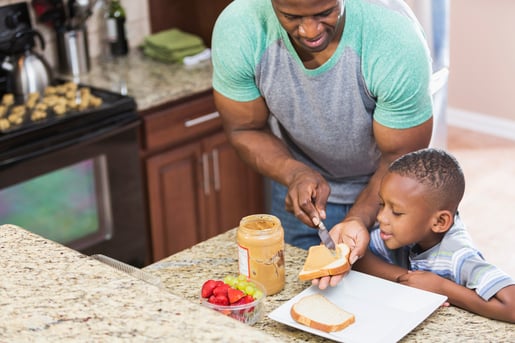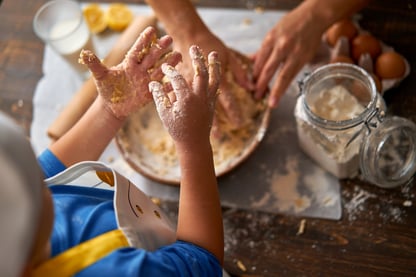Fun in the Kitchen! Teaching Developmentally Appropriate Cooking Processes to Autistic Learners
Using Task Analyses and Imitation Strategies
Preparing and gathering for a meal is a special social occasion for family and friends from all walks of life. Structured steps and visual aids may be beneficial for some people to participate in the meal preparation and cooking process, such as autistic individuals. Learning to cook from an early age is essential in building confidence in cooking practices and improving the quality of one’s diet.1
 The ability to make food is a cognitive processing and executive functioning skill that requires planning, sequencing of steps, and attention. Caregivers can help their learners be involved and enjoy cooking by collaborating in the process of making their favorite foods. A detailed task analysis (using pictures or video prompts) can be a beneficial tool for helping learners become independent in the cooking process.
The ability to make food is a cognitive processing and executive functioning skill that requires planning, sequencing of steps, and attention. Caregivers can help their learners be involved and enjoy cooking by collaborating in the process of making their favorite foods. A detailed task analysis (using pictures or video prompts) can be a beneficial tool for helping learners become independent in the cooking process.
What is a task analysis?
A task analysis is used to teach complex skills, such as brushing teeth or cooking. The entire chain of steps is taught systematically by breaking the process down into smaller steps. Static pictures that accompany a written task analysis can be a great tool to help autistic learners develop independent cooking skills, although research suggests that video modeling may be more effective.2
Young learners and inexperienced chefs can be taught to utilize a written, pictorial, or video task analysis to make a sandwich, cookies out of preformed cookie dough, and homemade pizza with a variety of toppings. Essentially, a recipe is a task analysis of necessary steps that must be followed in a specific order to obtain the desired result. All of these steps and lengthy details can be overwhelming, especially for people who desire direct and clear communication. A task analysis with guided prompts can be helpful for learners of all abilities to imitate the steps of completing a cooking task.

Example of a written task analysis:
Making a sandwich
- Open bread bag
- Pull out two pieces of bread
- Place bread on a plate
- Twist and close the bread bag - return back to storage space
- Scoop peanut butter with a knife
- Spread peanut butter on one slice of bread
- Scoop jam with a knife
- Spread the jam on the other slice of bread
- Lay bread with peanut butter to meet on top of bread with jam
- With a knife, cut the sandwich in half (triangle or square)
What is prompting and how can it be used to teach independent cooking skills?
Prompting may be required until the learner demonstrates independence in completing the target cooking behaviors. Visual aids, modeling, gesturing, and verbal descriptions are prompts that can be effective in teaching and maintaining new skills.
A visual task analysis can be immensely helpful when learning to cook a new food. When measuring items, such as flour or chocolate chips, the learner may benefit from a parent modeling how to scoop the ingredients using a measuring cup or using a spoon to scoop smaller amounts in a measuring cup. The learner can then imitate this action, thus increasing their independence.
Caregivers can point to the correct bowl in which to pour the ingredients and provide verbal cues for how to combine the mixture. As your learner becomes increasingly independent, the caregiver can fade (decrease) their prompts and only give support, as needed. The visual task analysis can be the last prompt that is used before the learner is independent in making the food item.
What is a developmentally appropriate cooking task for my learner?
 When determining which cooking tasks to engage in with the learner, consider the following: safety awareness, ability to follow verbal directions, acceptance of modeling or other prompts, independence, and need for supervision.
When determining which cooking tasks to engage in with the learner, consider the following: safety awareness, ability to follow verbal directions, acceptance of modeling or other prompts, independence, and need for supervision.
The ability to maintain safety awareness in the kitchen is of utmost importance as there are several tools and ingredients that can pose a risk of harm if handled incorrectly. For example, boiling water and using the oven requires one to notice and understand how to avoid burning themselves. When using raw food items such as eggs and meat, one must ensure sanitary conditions before, during, and after handling these ingredients.
Caregivers know their children best. If they have difficulty with portions of the cooking process, provide a higher level of prompting or simply model how to complete the steps while narrating the proper behaviors.
When and how can I start cooking with my learner?
Talk with your learner about their favorite foods and if they have any particular foods that they would like to learn to make. Cooking is a creative process and it can inspire people to try new foods!
With appropriate supervision, toddlers and preschoolers can engage in the cooking process with caregivers, especially through the use of visual task analysis. Children learn by engaging in an activity while being guided by a supporting caregiver who provides prompts, as needed, to encourage success and independence.
The ability to cook is associated with increased nutritional well-being and enhanced socialization,3 as the act of preparing and sharing a meal is inherently social in nature.
As the holiday season approaches, which foods are you most looking forward to creating and sharing with your learner?
Helpful Links
- Visual and Video Task Analyses
- POV Video Modeling for Autism: Harvest Trail Mix Goodie Bags
- Let's Cook! Life Skills - Kids with Autism - Beans Tacos with Tomato, Lettuce and Cheese (Level 3)
References
1. Lavelle, F., Spence, M., Hollywood, L., McGowan, L., Surgenor, D., McCloat, A., Mooney, E., Caraher, M., Raats, M., & Dean, M. (2016). Learning cooking skills at different ages: A cross-sectional study. International Journal of Behavioral Nutrition and Physical Activity, 13(1).
2. Mechling, L. C. & Stephens, E. (2009). Comparison of self-prompting of cooking skills via picture-based cookbooks and video recipes. Education and Training in Developmental Disabilities, 44(2), 218–236.
3. Goldschmidt, J., & Song, H.-J. (2017). Development of cooking skills as nutrition intervention for adults with autism and other developmental disabilities. Journal of the Academy of Nutrition and Dietetics, 117(5), 671–679.

Sheila Hartley, MS, BCBA, LBA
Sheila is an Early Childhood Education Consultant, BCBA, and the owner of SenseSational Learning Group LLC. She specializes in Naturalistic Developmental Behavioral Interventions. Play based learning is her passion and she gathers inspiration from the Reggio Emilia and Montessori approaches to early childhood education. She will graduate in 2023 with a Doctorate of Education in Early Childhood Education.




